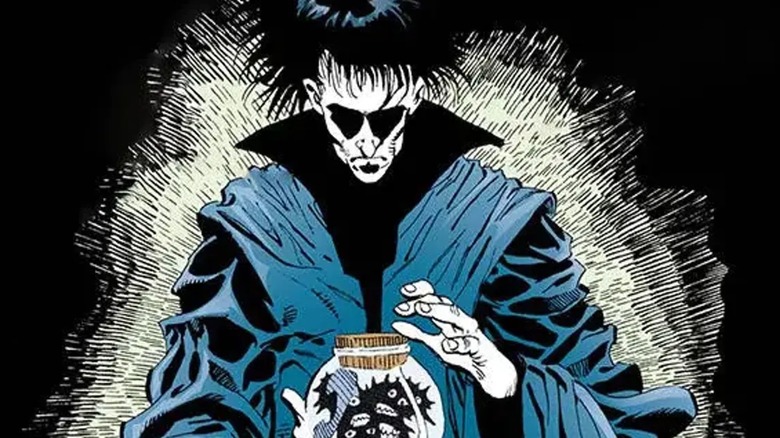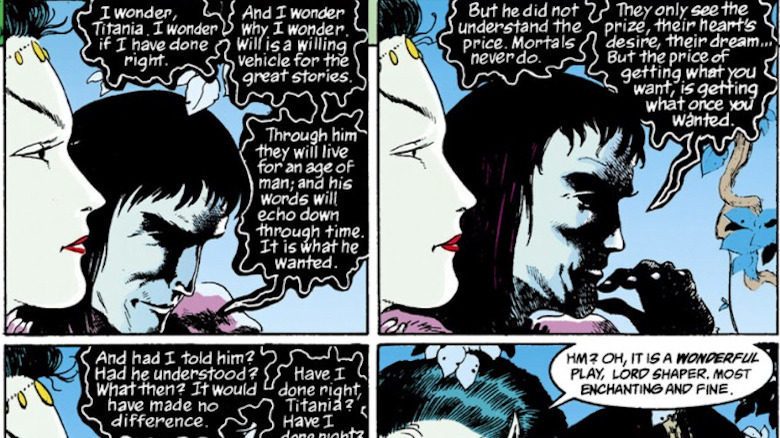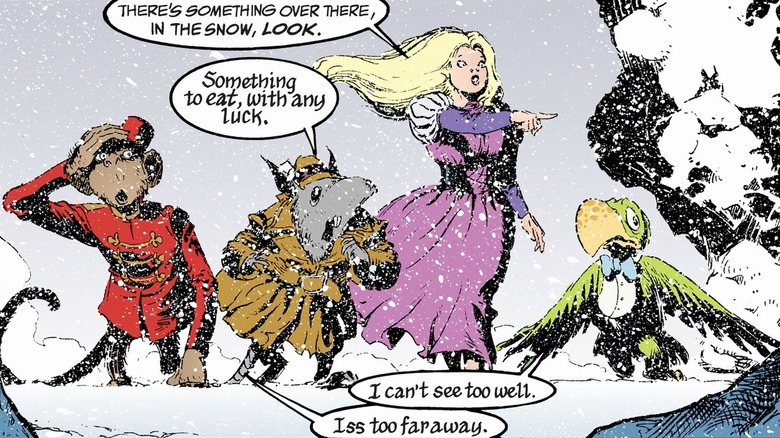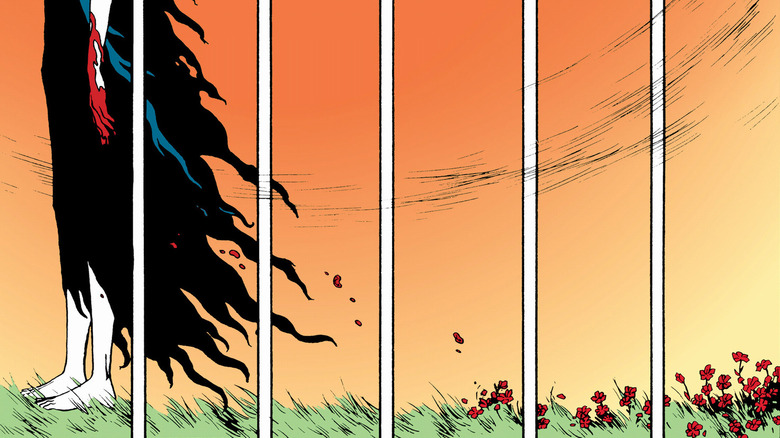The Future Sandman Storyline Neil Gaiman Is Most Excited To See
"The Sandman" is the comic that got me into comics. While I would go on to consume Marvel, DC, and every indie book in between, that love affair began with Neil Gaiman's magnum opus. I've been extremely nervous about Netflix's upcoming adaptation, because translating this comic from page to screen seems impossible. Gaiman probably put it best when he said in David Hughes' book "Tales From Development Hell" that the process of trying to make "The Sandman" into a movie was "like taking a baby and cutting off both of its arms and one of its legs and nose and trying to cram it in this little box, and filling the rest of the box up with meat."
Hughes' book came out quite a while ago and "The Sandman" has gone through countless iterations before and since Gaiman made that statement. After all, it's not just Gaiman's words that need to be adapted, but also the incredible work of artists such as Sam Kieth, Mike Dringenberg, Jill Thompson, Marc Hempel, and so many others. Gaiman spent decades keeping awful versions of "The Sandman" from being made and the project didn't truly come together until he sat down with David S. Goyer and Allan Heinberg. After much anticipation, "The Sandman" is set to drop on Netflix on August 5.
"The Sandman," which ran from 1989 through 1996, centers on Dream of the Endless, also known as Morpheus, Oneiros, and Kai'ckul, among other names. With the seminal comic series about to hit the small screen, there's not only the concern of whether or not the show will be good, but also the worry that Netflix won't give it enough time to tell Gaiman's epic tale. With a whopping 10 volumes, this is a show that needs at least five seasons. And looking ahead, what issues is Gaiman most excited to see adapted?
Things need not have happened to be true
/Film's Danielle Ryan attended a press day for the new series, where Gaiman was asked which story he is most excited to see adapted for Netflix. Gaiman responded:
"I'm really looking forward to seeing 'A Midsummer Night's Dream,' if we do that. It's one we can't cheap on, we can't take other shortcuts. We actually just have to do it and I can't wait to see what we'd actually make if we did that."
Drawn by the amazing Charles Vess, "A Midsummer Night's Dream" is #19 of "The Sandman" and is collected in the third volume of the series, "Dream Country." The comic won the World Fantasy Award for Best Short Story in 1991 and remains the only comic to ever do so — after its victory, the judging rules were rewritten to exclude comics from winning in a literature category in the future (via The Chicago Tribune).
The story takes place in 1593, as William Shakespeare leads his acting troupe around Sussex, England. The Bard — who'd been struggling to pen something memorable — and Dream had made a deal that Shakespeare's words would live on long after he's gone and, in exchange, he would write two plays about dreams for the Dream King himself. "A Midsummer Night's Dream" is the first of these plays and Morpheus invites an audience of fairies for the troupe's performance. For those unfamiliar with the Shakespeare play, it's partially set in Fairyland, and includes the characters of Fairy King and Queen, Oberon and Titania; Titania's servant Peaseblossom; and the mischievous sprite Puck; all of whom are in the audience. The comic examines the true cost of telling stories and Dream speaks one of my favorite "The Sandman" quotes, telling Titania, "The price of getting what you want, is getting what you once wanted."
Everybody has a secret world inside of them
The same question was asked to showrunner and executive producer Allan Heinberg, who responded with a different story:
"The one I'm the most scared of is 'A Game of You,' which means it's going to become my favorite because that's what happened this time around. But I also have been working on outlines for 'Brief Lives,' and I find 'Brief Lives' so powerful and so moving in ways that now that I'm an older person going back and rereading it, it just affects me profoundly. So I'm looking forward to both of those."
Drawn by incredible artists, including Shawn McManus, Colleen Doran, and Bryan Talbot, "A Game of You" is issues #32 through #37, which are collected in "The Sandman" volume five. Not generally a favorite among comic fans, the story would indeed be difficult to adapt, because it's so fantastical. Plus, it isn't really about Morpheus at all, but instead focuses on a previously minor character from earlier on in the series, Barbie. While she struggles to find her identity after her divorce, Barbie's dream life begins to overtake her waking one, and the results are catastrophic. The arc also prominently features her friend, Wanda, a rare trans character in comics at the time. While certain aspects of this story definitely need to be updated for a modern audience — a fact of which the writer is well aware — Gaiman's portrayal of Wanda was pretty revolutionary for the early '90s.
You cannot seek Destruction and return unscathed
The other arc mentioned by Heinberg is "Brief Lives," which is actually the first section of "The Sandman" I ever read, even though it's volume 7, which collects issues #41 through 49. An acquaintance handed it to me when I was 16 and I instantly fell in love with Jill Thompson's stunning art, as well as Dream's younger sister, Delirium. The story follows the two siblings as they search for their brother Destruction, who had abandoned his post long ago. Delirium, who was once Delight, is an excellent foil for Dream — who we all know can be a little too self-serious — as she drags him from place to place. "Brief Lives" remains my favorite volume of the series, and I agree with Heinberg completely about how the meaning of this story deepens and changes over time. It still hits me the hardest, which is saying something, considering one of the comic's best and most ambitious arcs, "The Kindly Ones," isn't far behind.
This story also includes one of the comic's most gut-wrenching moments, which takes place between Dream and his son, Orpheus. When I closed the book I was crying, even though I didn't completely understand what had just happened, having not read the preceding volumes. After that, I tracked down every volume I could find, reading them as a I went, and only going through the comics in order once I'd finally collected them all. I've reread the series many times since.
With "The Sandman" soon to hit our screens, now would be a great time for you to track down these books and read the entire series. There are plenty of formats for your reading pleasure, all of which are graced by Dave McKean's spectacular cover art.



